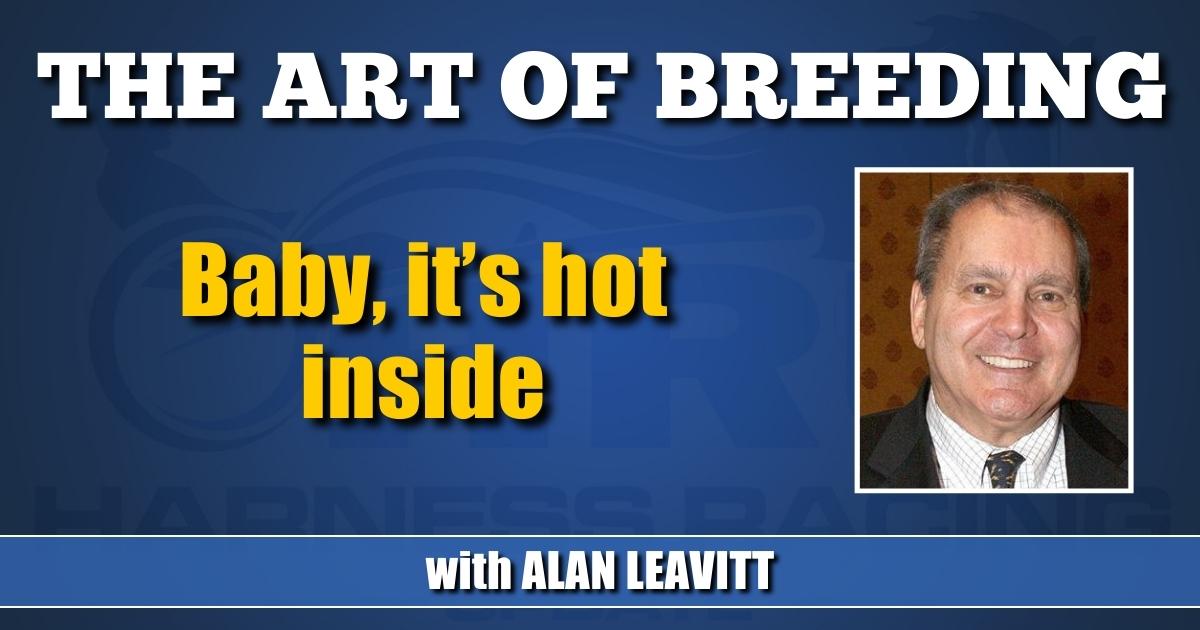

Baby, it’s hot inside
by Alan Leavitt
The standardbred market has never been hotter than it is today, as evidenced by the Blooded Horse Sale last Tuesday.
Glancing through the sales catalog, an open pacing mare caught my eye. She had good credentials, both as a race filly herself, and then as a producer from her first of three foals, and a good, if not great, pedigree.
However, on the minus side, the mare hadn’t had a foal last year, and she was selling open.
She was consigned, as agent, by Spring Haven Harm, aka Ms. Senena Esty, the young woman who is everything to all things horse related in Ohio.
So I gave her a call to get her take on what price range this mare would fall into. She did her usual thorough job, which included a discussion with the mare’s owner. The upshot was an informed opinion that the mare would sell for around $5,000.
Here’s the punchline. She brought $17,000.
I read with some bemusement the humor piece by Trey Nosrac about his breeding strategy (full story here). It’s still a free country, at least I hope so, so one can breed to any horse he wants to. If you want to be whimsical, be my guest. But to speculate about how a top sire would have fared if he started with fewer than 20 indifferent mares is a failure of logic.
By definition, a Muscle Hill or Walner (why didn’t she spell his name right?) had the racing creds that foreshadowed success in the stud. Sans his great record at 2, for me the definitive year, Muscle Hill simply isn’t Muscle Hill.
While it’s a fact that any horse’s phenotype, the visible horse, i.e. the racehorse, is totally disconnected from his genotype, or genetic profile, it makes no sense to speculate about any stallion by discounting one of his basic elements.
I’m really not one for doing matings by hunch, as Mr. Nosrac suggests, but there is a fertile field for an informed breeder to get good results from an unlikely source.
Here, in the interest of full disclosure, the breeder I’m going to be referring to is my beloved nephew, Seth Rosenfeld.
No one has bred more good horses from a very limited number of mares than Rosenfeld. A few years ago he sent his mare, Sweet Dahrlin, to Falcon’s Future. Here was a horse with virtually no popular appeal, but he had done enough, especially at 2, to rate Rosenfeld’s attention.
The result was a filly he named Sweet Future, and again he went against the popular vein and bred her to Yankee Cruiser. The result was Sweet Lou, a great racehorse, and a now a leading sire. If Mr. Nosrac ever decides to breed pacers, he should take a lesson from my nephew.
I was lucky enough to receive a welcome message from a good English friend, Gordon Garnett. He talks about inbreeding, with some valuable insights. I think perhaps I have not been clear enough about the necessity to inbreed only with superior individuals. Garnett points out how important that is, because when you inbreed, you heighten certain characteristics, and they better be good ones, or you’re a seven letter word that starts with “ph” and ends with “d”.
Garnett mentions the great Italian (or Eyetalion, as we say in Kentucky) horse Sharif Di Iesolo. He was sired by the strictly American-bred Quick Song, who was intensely inbred to Spencer. In case you forgot, Spencer was also the key player in Scott Frost’s pedigree, being 2 by 3 in the equation that produced that immortal racehorse.
I’ve also had a flattering email from Arie van Bellen. Unfortunately, he has posed a number of questions that it would take too many words and pages to answer, so I’m not able to oblige him with a response.
Like many of the people I hear from, van Bellen seems to know every bit as much about breeding standardbreds as I do. In addition, he’s also a linguist, speaking Dutch, French, and English. For my part, I have only a smattering of French, but I’m altogether fearless in speaking it. That comes from my two years of French at Andover, by the direct method.
For those unexposed to that particular form of educational torture, the direct method means only the studied language can be spoken in the classroom, starting with “Bonjour, Monsieur Forbush.” One blurted word of English meant a zero for the day.
As I said, I can’t begin to frame answers to all the questions van Bellen raises, but of all of them, the last thing I could do is give advice to both the Dutch and the other European breeders.
Obviously, the French have struck gold with a few of their good studs being crossed on American mares. So far, that’s all being done with frozen semen, which is not something a layman can deal with. One of their horses will have a real impact when he stands here in the flesh and can breed a full book of 140 mares. Or even better, stands in Canada, where I believe the book limit is 250.
On this subject, all praise is due Jean-Pierre Dubois, who has led the way in bringing French blood to American breeders. Years ago, Dubois also was the only breeder who took advantage of the brief time the French Studbook was opened to American blood. The horses he bred in America are still prominent in French pedigrees today.
So as a closing note, Senena Esty now joins the short list of women, headed by my wife, Meg, who could easily sell me a bridge. Or, if not the whole span, at least get the down payment.














